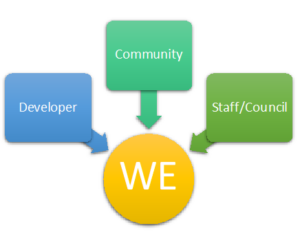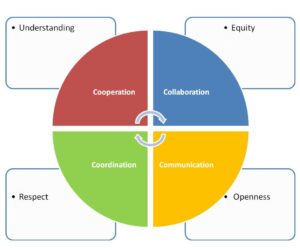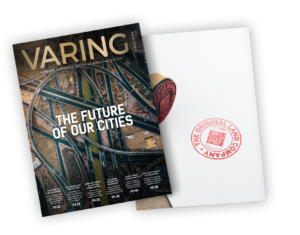We are happy to share that we had the privilege of speaking with Michael von Hausen to discuss his take on building relationships with municipalities. With our 17 years of commitment to the industry and depth of knowledge working with land owners and developers, we understand just how important these relationships are throughout the development process - Michael has an interesting take on the four ways to build trust.
Building Positive Relationships with Municipalities
FCIP, RPP, CSLA, BCSLA, LEEP AP
Do you ever feel like David in the biblical story David and Goliath when you approach municipalities for development approvals? Do municipalities also feel like David when they deal with developers that want to control their decisions and directions? It really depends, in part, on your point of view. It also depends on if you have a trusted relationship with the municipality or the developer. If not, the development process can often become a battle of wills and different positions that undermine good intentions by both parties.

Now we can understand why it can take up to five years from property acquisition to construction in many cases. With conflicts and misunderstandings, never-ending delays – if not failure, can be the inevitable results. How do we change this picture of failure to success? A successful development approvals process starts with earning trust and ends in trusted relationships. Trusted relationships normally create more straight conversations with realistic views and the management of expectations – not unrealistic rose-colored glass views. This trust-building process takes time, is earned not presumed, and requires a sincere commitment.
The following are four ways to build TRUST in development approvals with municipalities and vice versa:
- Be Open to the third alternative: There are normally at least two alternatives to a plan – the developer’s plan and the community’s/municipality’s plan. The developer “needs” the 100 housing units and the community and municipality want only 50 units with significant park space. The developer normally illustrates more than they need so they can compromise with 75 units in the eventual negotiations.But what if we changed the game. We sat down together and first defined our principles, goals, and vision for the property. Then using that framework, we defined programs for the property including a variety of housing - townhomes, duplexes, and single-family with rights of first refusal on the purchase of some of the housing units by local community members. Valuable central park space is shaped, significant trees become part of a linear park system and valuable trail connections to the adjoining neighborhood are created. The collaboration results in 110 units, 35 more than anticipated.
 Moving from “Me” to “We”
Moving from “Me” to “We”
- Rules of Engagement: Defining the rules and expectations are paramount to a common understanding of how approvals will work. Without rules and the understanding of those rules, misunderstandings become the undoing of the process.For example: One engagement rule could be that the project’s municipal development engineer and planner be at every meeting concerning infrastructure to ensure that the technical and community concerns are addressed. Minutes of those meetings will be circulated to the delegated development team members so that all know the progress. The basis to this rule is that the principal project team members are at the meeting and the rest of the project team is informed of the results.
An early meeting with the municipality and the developer is tantamount to “breaking the ice”. Clarity of roles and responsibilities are important in supporting a process where multiple views are heard and included in the development plan. It will be a successful joint process by design.
- Engagement from the beginning: Normally, the engagement piece of the puzzle is the community and is left until towards the end. Many municipalities and regional districts are now requiring an earlier and proactive approach to engagement. This way, both the developer and jurisdiction get a sense of the support for the application and where the challenges remain. The active engagement of the complete staff and then council is also part of the engagement puzzle. Leaving one out or overlooking their importance can spell doom – both from a political and application point of view. Early informal meetings to establish expectations, a familiar relationship, and gain a sense of trust are important with both staff and council.Thinking you can bully staff or council is short sighted. One developer, a prominent lawyer in Vancouver, attempted to disqualify a Director of Planning from an application due to a perceived conflict of interest without my support. He eventually phoned me and admitted it did not work and that he would “eat crow.”

Early engagement can create confirmation early and support at the end
- Three levels of engagement: There are three levels of engagement that need to be recognized – staff, council and the community, not necessarily in that order. Each of staff, community, and council need a communication strategy that keeps all updated on progress with meetings, workshops and open houses as venues to keep all informed. The early meetings can be informal such as a pre-application meeting with staff or a coffee meeting with the president of the residential association.It is always good to build your community engagement plan with staff as they normally have experience in various areas of their municipality or regional district. They can also direct you to the key players in the community. It is always good to have a staff member to refer you to neighbourhood leaders so the eventual phone call to the community member is not without reference and support.
To conclude, I would like to offer an inspiring diagram that I developed as part of my successful negotiation practice: The Wheel of Trust. I often use this Wheel of Trust in my complex negotiations, especially when a lack of trust is undermining the process. The approach consists of four foundational elements:
- First understanding the other parties’ views and opinions of the project.
- Creating a sense of fairness in the deliberations.
- Being sincere in each gesture and comment.
- Showing a genuine expression of understanding the other parties’ views and comments. Treat others as you expect to be treated.
With these fundamental elements established and reconfirmed at the beginning of each meeting, or frequently, then cooperation, collaboration, communication, and coordination can follow. Without understanding, equity, openness, and respect being embraced and practiced, the project cannot proceed with the parties really working together.

The Wheel of Trust
Bio: Michael von Hausen
Michael is the author of New Pathways to Approvals: Developing Better Communities Together (Tellwell, 2021). He is President of MVH Urban Planning & Design Inc. and adjunct professor at Simon Fraser University and Vancouver Island University. He has facilitated the highly sought-after School of Development for the past twenty years for the Urban Development Institute (Pacific Region). See more and purchase his book at www.mvhinc.com
Interested in more updates like this?
Get news articles, advice, and market activity straight to your inbox.

